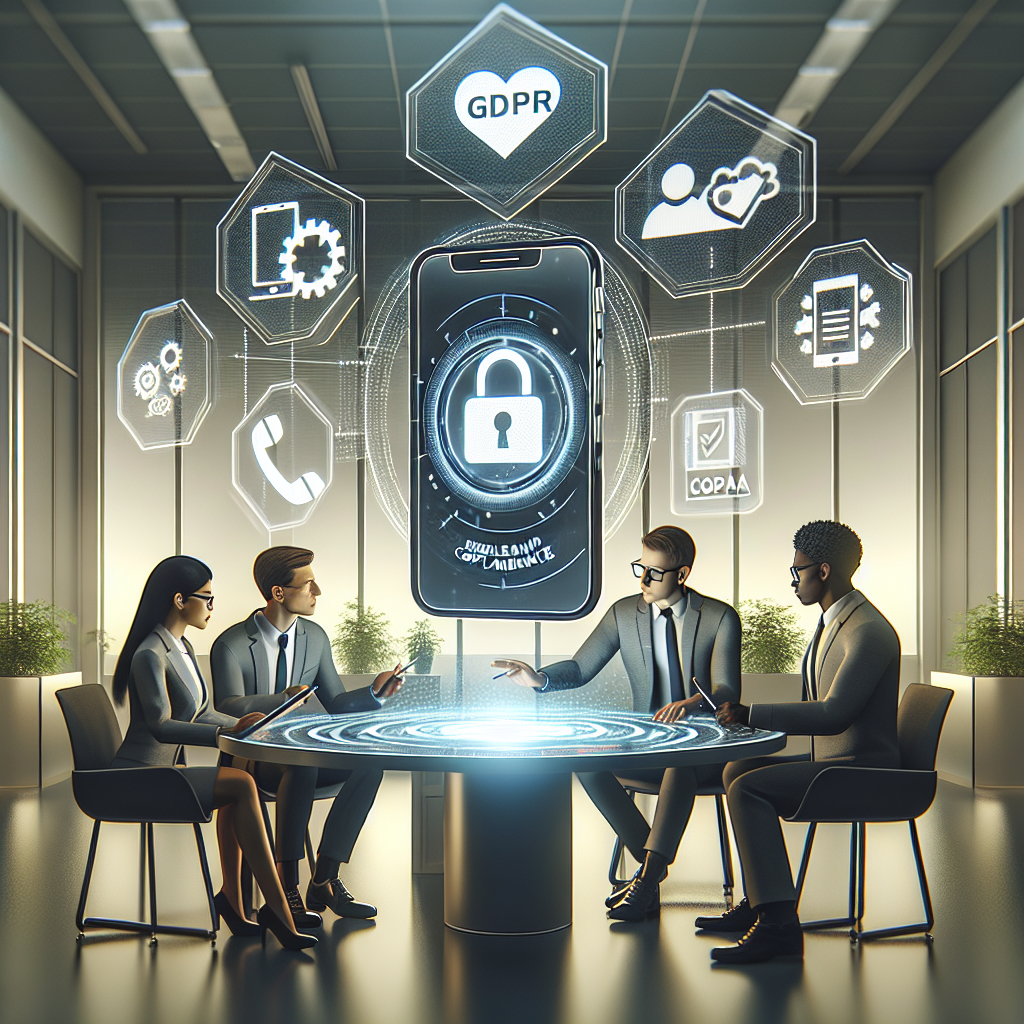In today’s fast-paced digital landscape, ensuring mobile app compliance is not just a regulatory necessity but a critical component of your app’s success strategy. With the proliferation of mobile applications across various industries, understanding the intricacies of compliance becomes essential for developers, marketers, and business owners. Mobile app compliance involves adhering to a set of legal and ethical standards that protect user data, maintain privacy, and foster trust among users.
Compliance requirements can vary significantly depending on the app’s target market and the data it collects. Key areas of focus include data protection laws like the GDPR in Europe, COPPA for apps targeting children in the U.S., and HIPAA for health-related apps. Failing to comply with these regulations can lead to severe penalties, legal issues, and loss of user trust. Therefore, a proactive approach to understanding and implementing compliance standards is crucial for any app that aims to thrive in the competitive market.
Moreover, mobile app compliance is not a one-time effort but an ongoing process. Regular audits, updates, and training are necessary to ensure that your app continues to meet evolving standards and user expectations. By prioritizing compliance, you not only safeguard your app from potential legal issues but also enhance its reputation and reliability among users.
At App Wise Consultings, we understand the complexities involved in achieving compliance. Our team of experts is ready to guide you through the process, ensuring your app meets all necessary standards. Book A Consultation Now! and take the first step towards a compliant and successful mobile application.
Understanding Legal Requirements for Apps
When developing a mobile application, understanding the legal requirements is paramount to ensure compliance and avoid potential legal pitfalls. Legal requirements for apps can be complex and vary across regions, making it crucial to be well-informed about the specific regulations that apply to your app’s target audience.
One of the primary considerations is data protection and privacy laws. Regulations like the General Data Protection Regulation (GDPR) in the European Union mandate strict guidelines on how user data should be collected, stored, and processed. Similarly, the California Consumer Privacy Act (CCPA) imposes requirements on businesses that handle personal information of California residents. For apps targeting children, compliance with the Children’s Online Privacy Protection Act (COPPA) is essential.
In addition to privacy laws, intellectual property rights are another key aspect of legal compliance. This involves ensuring that your app does not infringe on any existing patents, trademarks, or copyrights. It’s advisable to conduct thorough research and even seek legal counsel to navigate these areas effectively.
Moreover, apps that fall under specific industries, such as healthcare or finance, may be subject to additional regulations. For instance, health apps may need to comply with the Health Insurance Portability and Accountability Act (HIPAA) in the U.S., which sets standards for protecting sensitive patient information.
Ensuring your app is legally compliant not only safeguards it from potential lawsuits and fines but also builds trust with users by demonstrating a commitment to their rights and privacy. Taking the time to understand and implement these legal requirements can ultimately enhance your app’s success and longevity.
Implementing Data Privacy Measures

In today’s digital landscape, implementing robust data privacy measures is not just a regulatory obligation but a critical factor in building user trust. With increasing concerns over data breaches and misuse, app developers must prioritize the protection and privacy of user data.
The first step in ensuring data privacy is to adopt a privacy-by-design approach. This involves integrating privacy features into the app’s architecture from the onset, rather than as an afterthought. By doing so, developers can identify potential vulnerabilities early and design features that enhance user data protection.
It’s essential to implement encryption methods to protect data during transmission and storage. Encryption transforms data into a coded format, which makes it significantly harder for unauthorized parties to access. Utilizing SSL/TLS for data in transit and strong encryption algorithms for data at rest are fundamental practices.
Another critical measure is to ensure transparency with users regarding data collection and usage. This can be achieved by providing clear and concise privacy policies that detail what data is collected, how it is used, and with whom it is shared. Regularly updating these policies and notifying users of any changes is also vital.
Additionally, implementing user consent mechanisms is crucial. Apps should obtain explicit consent from users before collecting any personal data, and users should have the ability to revoke consent at any time. This not only aligns with legal requirements like GDPR but also empowers users to control their data.
Beyond technological measures, fostering a culture of privacy within the development team is equally important. Regular training and awareness programs can ensure that all team members understand the importance of data privacy and adhere to best practices.
Ensuring Security and User Protection

In the realm of mobile application development, ensuring security and user protection is paramount. Users entrust apps with sensitive information, and any breach of this trust can lead to significant reputational and financial damage.
One of the fundamental steps in securing a mobile app is to implement multi-factor authentication (MFA). MFA adds an additional layer of security by requiring users to provide two or more verification factors to gain access. This drastically reduces the likelihood of unauthorized access, even if a user’s password is compromised.
Another critical aspect is conducting regular security audits and vulnerability assessments. These audits help identify potential security loopholes and ensure that the app’s defenses are up to date against the latest threats. Employing ethical hackers to perform penetration testing can also provide insights into potential vulnerabilities that might be overlooked.
Secure coding practices are essential to prevent common security threats such as SQL injection, cross-site scripting (XSS), and buffer overflows. Developers should be trained to write secure code and use automated tools to scan for vulnerabilities during the development phase.
Data protection is not limited to encryption; secure data storage practices are equally important. Storing sensitive data in secure locations and ensuring that only authorized users have access can prevent data leaks and unauthorized access. Additionally, implementing regular backups ensures that data can be recovered in case of accidental loss or corruption.
Finally, keeping the app and its underlying libraries and frameworks up to date is crucial. Regular updates not only introduce new features but also patch known vulnerabilities. Encouraging users to update the app frequently is an effective way to maintain a secure environment.
By prioritizing security and user protection, developers can create a safe and trusted environment that fosters user confidence and long-term engagement.
Best Practices for App Compliance

Adhering to best practices for app compliance is not only essential for legal reasons but also to build trust with users and stakeholders. Compliance ensures that your app meets industry standards and regulations, safeguarding both the organization and its users.
Firstly, it is crucial to understand the regulatory landscape that applies to your app. This includes complying with data protection regulations such as the GDPR in Europe, the CCPA in California, and other local laws that govern data privacy and security. Staying informed about these regulations and any changes is essential to remain compliant.
Documentation plays a significant role in compliance. Maintain comprehensive records of your app’s data processing activities, consent forms, and privacy policies. This documentation will not only help during audits but also in demonstrating transparency and accountability to users.
Integrating a robust privacy policy and ensuring it is easily accessible to users is another best practice. The privacy policy should clearly outline what data is collected, how it is used, and with whom it is shared. Users should be informed about their rights regarding their personal data and how they can exercise those rights.
Regular compliance training for your team is essential to keep everyone updated about the latest compliance requirements and best practices. This training should cover the importance of compliance, the potential risks of non-compliance, and the procedures to follow to ensure ongoing adherence to regulations.
Finally, leveraging technology to automate compliance processes can help streamline efforts. Tools that monitor regulatory changes, manage data privacy, and automate alerts can reduce the manual effort required to maintain compliance.
By following these best practices, you can ensure that your mobile app not only meets legal requirements but also earns the trust and confidence of your user base.
Monitoring and Updating Compliance Standards

Ensuring ongoing app compliance is an evolving process that requires consistent monitoring and updating of compliance standards. As regulations change and new risks emerge, it’s vital to keep your app aligned with the latest requirements to protect both your business and users.
One of the first steps in this process is to establish a dedicated compliance team or assign the responsibility to qualified personnel. This team should be equipped to regularly review and assess the app’s compliance status against current regulations and industry standards. They should also monitor for updates or changes in laws that could impact your app.
Implementing a continuous improvement process is beneficial. Regular audits and assessments can identify potential compliance gaps and areas for improvement within your app. Utilize checklists and compliance management tools that provide real-time updates on regulatory changes, ensuring you remain proactive rather than reactive.
Collaboration with legal experts and regulatory bodies can offer valuable insights into upcoming changes and how they might affect your app. Engaging with external consultants can also provide a fresh perspective on your compliance strategy, helping you to stay one step ahead.
It’s crucial to update your app’s privacy policy and user agreements as needed to reflect any changes in compliance standards. Keeping users informed about these updates is not only a legal requirement but also a way to maintain trust and transparency.
By actively monitoring and updating compliance standards, you can mitigate risks and ensure your app remains competitive in the market. Stay ahead of the curve and protect your app’s future—Book A Consultation Now! to explore how we can assist in navigating these complexities.
